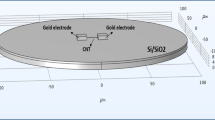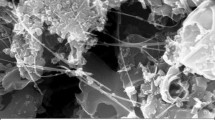Abstract.
The objective of this study is to model and simulate the behavior of a new biosensor based on carbon nanotubes to detect, automatically and autonomously, the presence of acetone molecules. A 3D model, based on finite elements of SWCNTs, is proposed and developed using the FE code of the ANSYS simulator. We have developed a study on the dynamic behavior of the carbon nanotube for two clamped-clamped and clamped-free structures, by determining the frequency shift of the nanotube resonator, which varies as a function of the attached mass of acetone molecules. We found that the nanotube resonator can detect one single acetone molecule. A parametric study was conducted to highlight the influence of the nanotube diameter, the length of the nanotube, the attached molecule position and the boundary conditions on the natural frequencies of the nanotube. A multilayer neural network has been used to model the behavior of our acetone sensor. We have shown that artificial neural networks (ANNs) replace our acetone sensor because they faithfully reproduce its behavior and take into account dependence on the structural parameters. The neural network model of the sensor thus obtained was implemented on the SPICE simulator, which allowed us to simulate the operation of an electric environment and therefore assess its performance.
Similar content being viewed by others
References
C. Stampfer, T. Helbling, D. Obergfell, B. Schöberle, M.K. Tripp, A. Jungen, S. Roth, V.M. Bright, C. Hierold, Nano Lett. 6, 233 (2006)
J. Chaste, A. Eichler, J. Moser, G. Ceballos, R. Rurali, A. Bachtold, Nat. Nanotechnol. 7, 301 (2012)
S.A. Gohari, J. Abdi, M.K. Hafshejani, A. Arad, World Appl. Sci. J. 18, 1749 (2012)
H. Bridle, W. Wang, D. Gavriilidou, F. Amalou, D.P. Hand, W. Shu, Sensors Actuators A 247, 144 (2016)
R. Chowdhury, S. Adhikari, IEEE Trans. Nanotechnol. 10, 659 (2011)
R. Chowdhury, S. Adhikari, J. Mitchell, Science Direct - Physica E 42, 104 (2009)
I. Mehdipour, A. Barari, G. Domairry, Comput. Mater. Sci. 50, 1830 (2011)
A.Y. Joshi, S.C. Sharma, S.P. Harsha, Sensors Actuators A 168, 275 (2011)
S.K. Georgantzinos, N.K. Anifantis, Physica E 42, 1795 (2010)
I. Mehdipour, A. Erfani-Moghadam, C. Mehdipour, Curr. Appl. Phys. 13, 1463 (2013)
J.H. Lee, B.S. Lee, Comput. Mater. Sci. 51, 30 (2012)
D. Wu, W. Chien, C. Chen, H. Chen, Sensors Actuators A 126, 117 (2006)
C. Li, T.W. Chou, Int. J. Solids Struct. 40, 2487 (2003)
D.H. Wu, W.T. Chien, C.S. Chen, H.H. Chen, Sensors Actuators A 126, 117 (2006)
Z.L. Wang, R.P. Gao, P. Poncharal, W.A. de Heer, Z.R. Dai, Z.W. Pan, Mater. Sci. Eng. C 16, 3 (2001)
Y. Yan, G. Shi, P. Zhao, J. Comput. 6, 1125 (2011)
S. Prabhu, S. Bhaumik, B.K. Vinayagam, J. Mech. Eng. Res. 4, 260 (2012)
M.B. Panchal, S.H. Upadhyay, Mol. Simul. 40, 1035 (2014)
Keun Su Kimv et al., Semiconduct. Sci. Technol. 32, 013003 (2016)
F. Djeffal, Z. Dibi, M.L. Hafiane, D. Arar, Mater. Sci. Eng. C 27, 1111 (2007)
F. Djeffal, A. Abdi, Z. Dibi, M. Chahdi, A. Benhaya, Mater. Sci. Eng. B 147, 239 (2008)
F. Menacer, A. Kadri, F. Djeffal, Z. Dibi, H. Ferhati, Modeling of boron nitride-based nanotube biological sensor using neural networks, in The 17th international conference (STA’2016), IEEE, Sousse, Tunisia, December 2016 (IEEE, 2016)
F. Menacer, A. Kadri, F. Djeffal, Z. Dibi, H. Ferhati, Modeling and investigation of smart capacitive pressure sensor using artificial neural networks, in 6th International Conference on Systems and Control (ICSC 2017), IEEE, Batna, Algeria, May 2017 (IEEE, 2017)
Author information
Authors and Affiliations
Corresponding author
Rights and permissions
About this article
Cite this article
Menacer, F., Dibi, Z. & Kadri, A. Modeling a new acetone sensor based on carbon nanotubes using finite elements and neural network. Eur. Phys. J. Plus 133, 238 (2018). https://doi.org/10.1140/epjp/i2018-12059-1
Received:
Accepted:
Published:
DOI: https://doi.org/10.1140/epjp/i2018-12059-1




